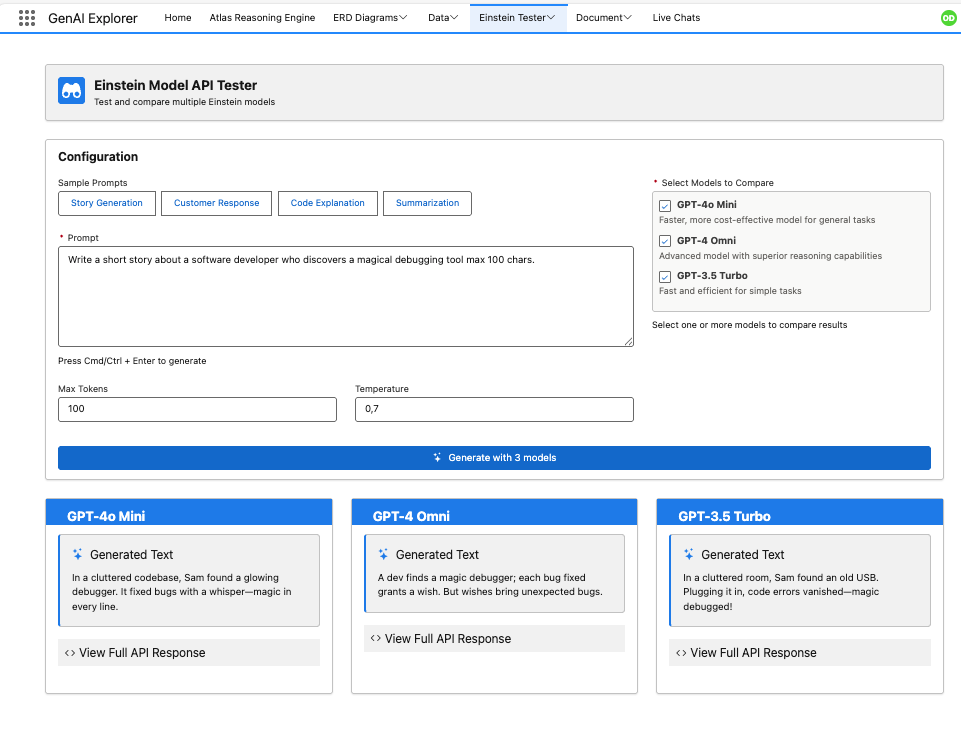Einstein Model Testing
Test and compare Einstein AI models directly from your browser with custom prompts, parameter control, and real-time results.

The Problem
Choosing the right AI model for your use case requires understanding the tradeoffs between cost, speed, and quality.
When building AI solutions, teams need to:
- 🎯 Model Selection: Determine which model provides the best balance for specific use cases
- 💰 Cost Optimization: Understand token consumption and pricing implications
- ⚡ Performance Testing: Compare response times across different models
- 🎨 Quality Assessment: Evaluate output quality for your specific prompts
- 🔧 Parameter Tuning: Experiment with temperature, max tokens, and other settings
- 📊 Side-by-Side Comparison: Test multiple models with identical inputs
In short: You need a sandbox to experiment with different models and parameters before committing to production.
How GenAI Explorer Solves This
GenAI Explorer provides comprehensive model testing with:
✅ Side-by-Side Comparison: Test multiple models with identical prompts simultaneously
✅ Parameter Control: Adjust and understand key settings
- Temperature (creativity vs consistency)
- Max tokens (response length limits)
- Top-p, frequency penalty, presence penalty
✅ Cost Transparency: See token usage and estimated costs in real-time
✅ Performance Metrics: Compare response time, quality, and token efficiency
✅ Sample Prompts Library: Pre-built prompts for common scenarios
- Customer service responses
- Data analysis
- Code generation
- Creative writing
✅ A/B Testing: Save and compare results across multiple test runs
✅ Prompt History: Automatically saves all your tests
- Access previous prompts instantly
- Re-run past tests with one click
- Compare results across time
- Track improvements and iterations
Impact: Choose the right model for each use case, reduce costs by 50-70% with smarter model selection, and validate quality before deployment.
Quick Start Guide
1. Access Model Testing
Navigate to Einstein Model Testing from the main menu.
2. Select Models to Compare
Choose one or more models:
- ☐ GPT-4 Omni
- ☐ GPT-4o Mini
- ☐ GPT-3.5 Turbo
Pro Tip: Select multiple models to compare results side-by-side.
3. Enter Your Prompt
Type or paste your prompt in the text area.
Try a sample prompt:
Explain quantum computing in simple terms for a 10-year-old.
4. Configure Parameters
Start with defaults and adjust as needed:
- Temperature: 0.7 (balanced)
- Max Tokens: 500
- Top P: 1.0
Need help?
- See the Temperature Guide for creativity control
- Check Parameters Reference for all options
5. Generate & Compare
Click Generate to see results from all selected models side-by-side.
Key Features
Side-by-Side Comparison
Compare multiple models with identical inputs:
┌─────────────────────┬─────────────────────┬─────────────────────┐
│ GPT-4 Omni │ GPT-4o Mini │ GPT-3.5 Turbo │
├─────────────────────┼─────────────────────┼─────────────────────┤
│ Response Time: 3.2s │ Response Time: 1.8s │ Response Time: 0.9s │
│ Tokens: 342 │ Tokens: 285 │ Tokens: 198 │
│ Cost: $0.010 │ Cost: $0.004 │ Cost: $0.001 │
│ │ │ │
│ [Response content] │ [Response content] │ [Response content] │
│ │ │ │
└─────────────────────┴─────────────────────┴─────────────────────┘
Metrics displayed:
- Response time
- Token usage (input + output)
- Cost estimate
- Word/character count
- Quality indicators
Real-Time Results
See responses as they're generated, with live metrics updating.
Prompt History
Automatically saves every test you run - never lose your work!
Key Features:
- 📜 Browse History: View all previous prompts and results
- 🔄 One-Click Re-run: Test again with saved settings
- 📊 Compare Results: See how responses changed over time
- 📈 Track Iterations: Monitor prompt improvements
- ���💾 Export Data: Download for analysis or reporting
- 🔍 Search: Quickly find past tests by keyword
Use Cases:
- Resume testing sessions
- Compare model changes over time
- Share successful prompts with team
- Document testing process
- Audit model performance
Common Use Cases
1. Model Selection
Goal: Choose the right model for your production use case
Process:
- Test your actual use case prompts with all models
- Compare quality, speed, and cost
- Run multiple variations to test consistency
- Choose the model that best balances your priorities
Example Decision:
- GPT-4 Omni for complex legal document analysis
- GPT-4o Mini for general customer support
- GPT-3.5 Turbo for simple data classification
2. Quality vs Cost Analysis
Goal: Determine if premium models justify their cost
Example Results:
- 10,000 requests/month
- GPT-4 Omni: $300/month, 95% quality score
- GPT-3.5 Turbo: $20/month, 85% quality score
- Decision: Use GPT-3.5 for 80% of requests, GPT-4 for complex cases
3. Parameter Optimization
Goal: Find optimal temperature and token settings
See: Temperature Guide for detailed guidance
4. Prompt Engineering
Goal: Refine prompts for better results
Process:
- Start with a basic prompt
- Test and save to history
- Review results
- Refine and test again
- Compare with previous versions in history
- Choose the best performing prompt
Pro Tip: Use prompt history to track which variations performed best!
See: Sample Prompts for inspiration
Documentation
Guides
- Temperature Guide - Choose the right creativity level
- Parameters Reference - Understand all configuration options
- Sample Prompts - Pre-built prompts for common scenarios
- Model Comparison - Detailed performance analysis
- Best Practices - Tips for effective testing
- Cost Optimization - Strategies to reduce spending
Related Features
- Chat with Agents - Test models in agent context
- RAG & Retriever - Optimize knowledge retrieval
- Prompt Builder - Test prompt templates
Next Steps
- Start Simple: Begin with a basic prompt and default settings
- Compare Models: Test with multiple models side-by-side
- Adjust Parameters: Fine-tune temperature and token limits
- Test Variations: Try different prompt formulations
- Document Results: Save and compare your findings
- Deploy: Use insights to configure your production implementation
Effective model testing leads to better AI implementations and significant cost savings.